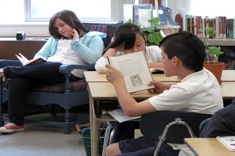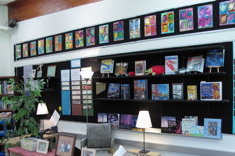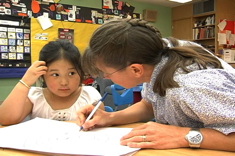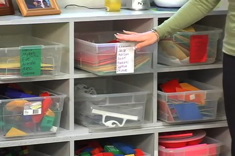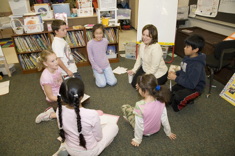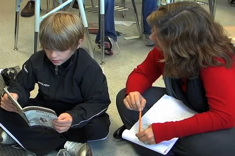“I see children as kites …” writes Erma Bombeck. “You spend a lifetime trying to get them off the ground. You run with them until you’re both breathless … they crash…you add a longer tail … they hit the rooftop … you pluck them out of the spout. You patch and comfort, adjust and teach. You watch them lifted by the wind and assure them that someday they’ll fly. Finally, they are airborne, but they need more string and you keep letting it out. With each twist of the ball of twine, there is a sadness that goes with the joy because the kite becomes more distant, and somehow you know that it won’t be long before that beautiful creature will snap the lifeline that bound you together and soar as it was meant to soar — free and alone. Only then do you know that you did your job.
Erma Bombeck knew, just as we do, that kids need lots of practice, guidance and support in order to soar free and alone. But what kind of practice? What kind of guidance and support? The answers, of course, come from the needs of our students and vary day-to-day, month-to-month and year-to-year.
There are lots of ways to release responsibility to children and move them forward. I want to notice and name some of the supports in place in classrooms that encourage and guide children toward independence.
Language
Once again we’re back to language! But when we say things like…
- Listen to you — you already know so much!
- Don’t worry — I’m not going to ask you to do anything I know you can’t do. Are you ready?
- Wow! You know a lot about nonfiction already.
- That happens to you, too? Whew! I’m glad I’m not the only one.
- I can’t wait to see what we learn!
- That’s it exactly.
- Do you see any other connections we can make?
… we’re honoring children and what they already know, offering reassurance that they’re going to be good at this and letting them know we’re going to be figuring this out together.
Body language matters, too. By simply leaning in to listen, giving a thoughtful, knowing nod or smiling at a child’s response, we encourage and support kids in their endeavors, and make our words ring true.
Turning and Talking
I’d be hard pressed to think of a lesson where I haven’t asked kids to get eye-to-eye and knee-to-knee and talk at least several times. It’s fast, fun, and engages everyone. Turning and talking gives children opportunities to process information, construct meaning and enhance understanding, share ideas and learn from each other and practice what we’re working so hard to teach them in an authentic, natural way.
And when hands are flying or you just can’t bear to hear another connection (no matter how meaningful) you can say something like, “Wow, boys and girls. I can tell you have so much thinking to share. Everyone, get eye-to-eye and knee-to-knee and talk about …”
Partner Work
Kids love to work with partners, and I often think about purposeful ways to incorporate partner-work into my lessons. Many times students aren’t yet ready right after a lesson to read, think about their new learning and record it independently. But doing all that with a partner? No problem!
And even if some may be ready, I’d probably ask them to choose someone to work with. Partner work often plays a role in my lesson design. That’s because I believe in the social nature of learning. I want kids to talk! I want to them share ideas, puzzle through something together, listen and learn from each other. Partner work is yet another way to engage, motivate, and create a collaborative, cooperative spirit in our classrooms and our schools.
What’s the teacher doing while children are working? We’re at tables and on the floor, conferring with students, listening in, asking questions and recording what we learned. We resist the temptation to tell, to push our ideas or give them advice. We’ve already shown them enough to get them started, and now kids can have a go at it with the support of each other.
Book Selection
When we release responsibility to children and ask them to try something new, short text that kids can read easily is hands-down best. That way, when children are practicing, they can see a book through from start to finish in a day or two, and they can put all their energy into comprehension without making heavy demands on them in other respects, such as background knowledge, vocabulary load, or decoding.
Depending on what children are learning, well-crafted picture books, poetry, newspaper and magazine articles, big books, short fiction and nonfiction pieces all fill the bill. And don’t forget wordless books! They’re perfect for our youngest readers who haven’t yet or who are just beginning to crack the code or as an interesting, eye-opening option for more fluent readers. Favorite wordless titles include:
A Circle of Friends by Giora Carmi
The Hunter and the Animals by Tomie dePaola
The Red Book by Barbara Lehman
Museum Trip by Barbara Lehman
Zoom and Re-Zoom
by Istvan Banyai
The Dog and Frog Series by Mercer Mayer
Why? by Nicolai Popov
Flotsam and others by David Weisner
Home by Jeannie Baker
Looking Down by Steve Jenkins
Authentic Response
Sticky notes — where would we be without them? Keeping track of thinking on sticky notes is probably the most authentic of responses to reading — it’s just like writing in the margins of books when they’re ours. When I think about ways for students to respond, I ask myself …
- Is what I’m asking kids to do purposeful? Authentic? Necessary?
- Is it open-ended?
- Might it be used across the day, in other subjects or classes?
- Does it serve as a means to comprehension as well as a measure? How will it help children construct meaning and enhance their understanding?
- Do children have opportunities (over time) to respond in a variety of oral, written, artistic and dramatic ways?
You’ll know when and how to release more responsibility to students as you learn what they need from them. So put yourself in the moment, teach, and listen to what your students have to say. You don’t have to know everything, but you do know something. Be genuine. Listen. Be open to new ideas and ways of thinking. And when you are, you’ll know in your heart and mind what comes next. You really will.

